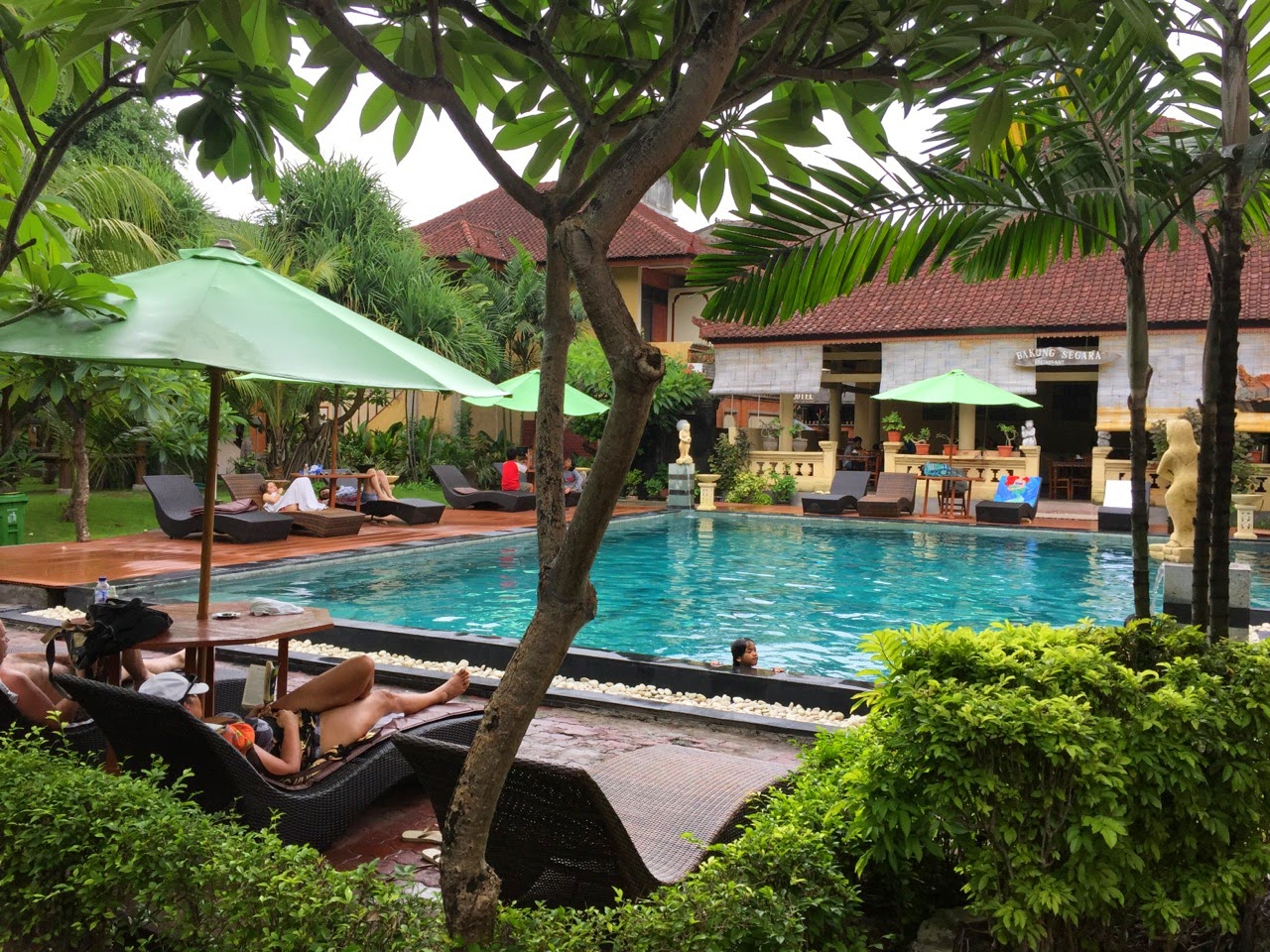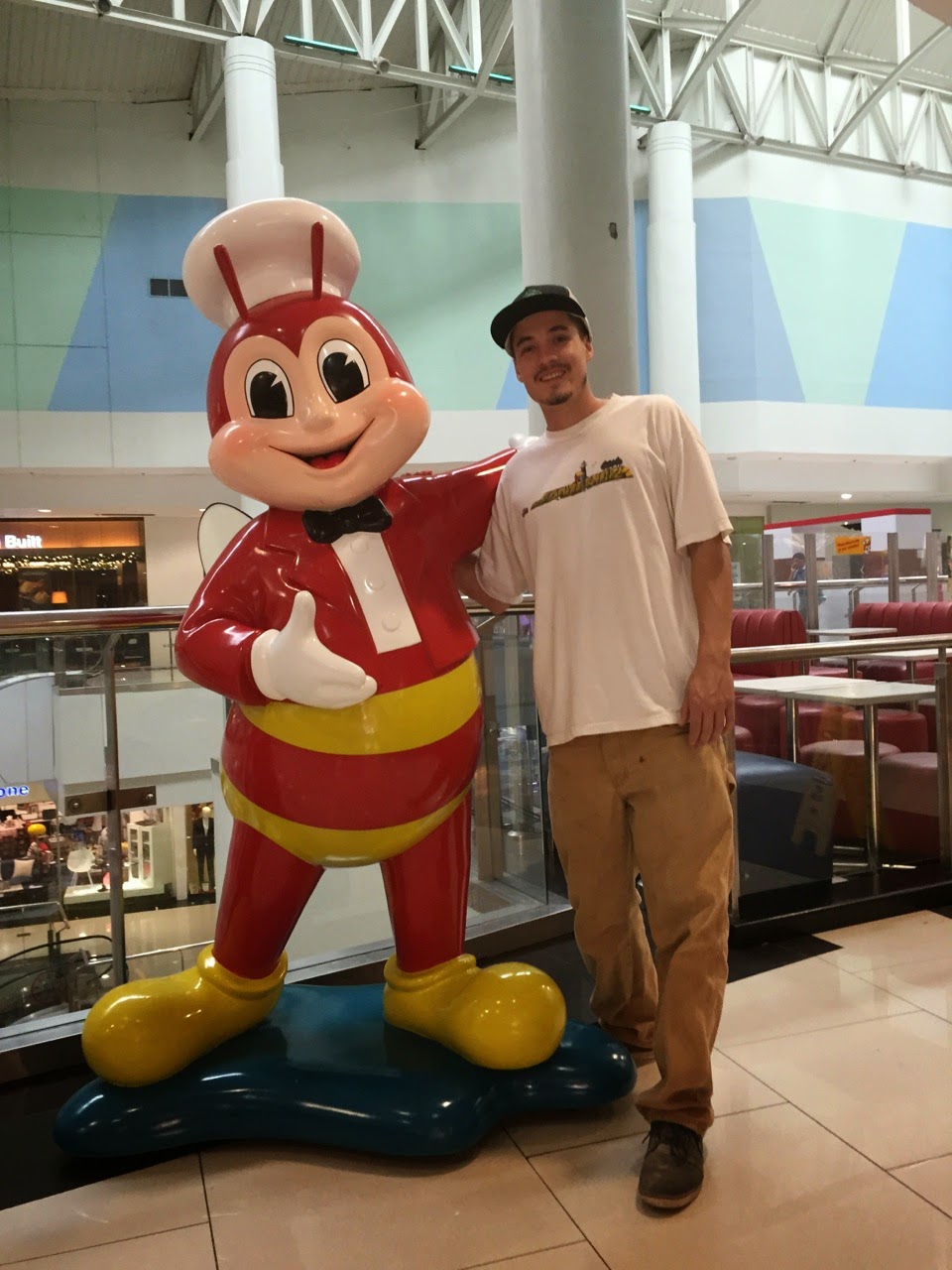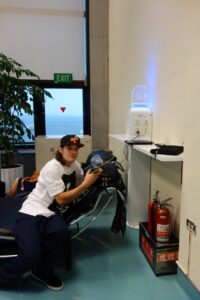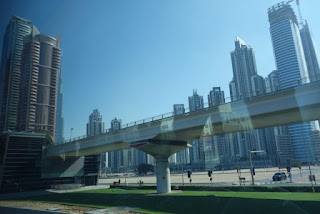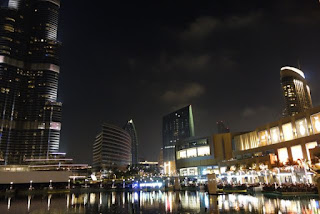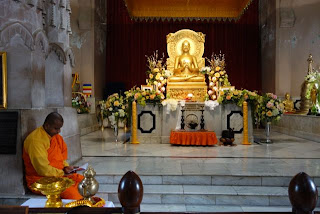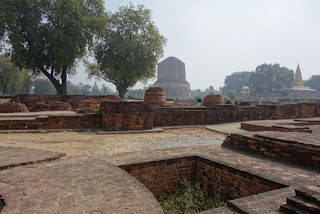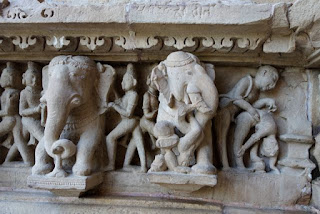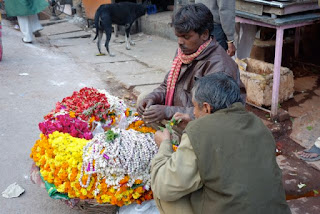January 25th. Dubai to Abu Dhabi and Home at Last!
It’s a good thing that I have set John’s alarm or we might have slept several more hours. I shower, dress and leave our room quietly to check on the times for breakfast. A handful of guests are eating breakfast in the canvass covered courtyard and I am happy to discover it is only 9:15 A.M. John’s phone was set on New Deli time, not Dubai time and there is a 1 ½ hour difference. While John showers, I send e-mail to Art with our arrival information into S.F.O. and attempt Skype again without success. A few minutes later, my computer rings and it is Art calling. It’s heartening to hear his voice and both John and I talk excitedly with him for several minutes.
We sit in the canvas shaded courtyard and enjoy strong coffee, creamy yoghurt, omelets, tahini and Arabic bread and with map and guidebook in hand, make our plans for the day. For $55 each, we could take the guided tour on the double-decker “Red Bus” and be limited to their schedule, or we can take taxis to the same sites for what I hope will cost about half. I look over the Red Bus itinerary and make note of their stops, starting the farthest away and working back towards our hotel.
 |
| Bastakiya Dubai |
 |
| Bastakiya guard and John |
We stash our luggage in a corner of the tiny office, close the heavy wooden doors to this artsy, 9 room guest house and navigate from the maze of the historical district out to the main street. There are very few tourists out yet, but each time I lift my camera to take a photo, a nuisance-some tourist rounds a corner of this historical labyrinth and pops into my view finder. I’m sure they are equally irritated when John and I pop into one of their photographs. I am taking a photo of John in the narrow shaded lane when a security guard crosses. He spots my pointed camera, beams and indicates that he wants his photo taken beside John. I happily oblige and show him the image in the back screen of my camera. He walks beside us and tells us he is from Nepal and proudly shows us his laminated identification work card. If I understand correctly, he has a two year permit; works for 9 months, returns home for 3 months and repeats the process. In broken English, he tells us that Nepal is poor but the USA is good and is helping in Nepal. He relays that his family was “bad” but now they are a “nice” family because he has work in Dubai and can send money home. These brief encounters are much of what makes traveling such a joy.
The taxis in Dubai are metered, starting at 3 dirham, and in less than a minute we are scooped up and are driving towards the Dubai Marina. I have been told to expect the 25 minute drive to the Marina to cost about 60 dirham and the meter shows 58 dirham when we arrive.
 |
| John at Dubai Marina |
 |
| Dhow at Dubai Marina |
An elegant pedestrian promenade curves along the waterfront and shimmering yachts are moored in this inner harbor, reflecting the morning sunlight off the water. Wait staff are readying the sidewalk Cafes and restaurants lining the promenade. Although there are many tourists and foreign families out with their children, it is Friday, a holy day, and there are few Arabs out at 11:30 A.M. (It is no wonder since they were all at the Dubai Mall at midnight last night!) Earlier, we considered taking the metro to the Marina, but on Fridays, even the metro does not open until 1:00 P.M. Except for the futuristic high rises and sky scrapers piercing the skyline, we could be strolling along the marina at Cabo San Lucas or any number of other upscale harbors in sundrenched parts of the world.
 |
| Marty at a Dubai Marina Cafe |
 |
| Arab women walking the Marina Promenade |
We take turns taking photos of each other, leaning up against the railing, boats and skyscrapers in the background. Although there are many small and medium sized yachts in the marina, John wants to know where the big boats play? We succumb to the touristy lure of Captain Jack’s, 1 hour dhow cruise, a circular loop of both the inner and outer harbor. 120 dirham later, ($33) the two of us are settled comfortably into overstuffed tribal upholstered beanbags on the canvass shaded deck of a large wooden dhow.
 |
| Captain Jacks Marina and Harbor Cruise |
The boat could easily accommodate over 50 passengers but we are two of less than 20 other passengers on this cruise. The dhow motors out of the harbor and I wish immediately for our jackets that we have left stored with our luggage back at the hotel. John points out several immense yachts moored in the outer harbor, but surprisingly, they pale in comparison to the jaw dropping yachts we sae in the harbor at Cairns, Australia. A helicopter sits atop a helipad and a ribbon of a runway, constructed on pylons, with yellow and black reflecting girds at its end, stretches out into the ocean. It is cold and foggy outside of the inner harbor and the skyscrapers have all but disappeared excepting the tips of a few, peeking eerily out and above the fog bank.
 |
| Helicopter and Fog |
 |
| Fog on the landing strip in the outer harbor |
 |
| Cranes in the Dubai Marina |
 |
| Cranes in the Dubai Marina |
 |
| Re-entering the Dubai Marina by Dhow |
We catch a second taxi towards Palm Jumeirah, the “Crescent and Frond” development with the Atlantis resort at its tip. When one sees photos of Dubai, it is the futuristic Burj al Arab hotel and the Crescent and Frond community that epitomizes Dubai.
 |
| Burg Al Arab |
 |
| Atlantis Resort |
I am disappointed that we can see little of this artificial island community, sans for the gated entrances to each “frond.” Each “frond” is constructed along an artificial canal so that every luxury estate has a waterfront view. I catch a glimpse or two of a canal through the security gates but the aerial photos I have seen are stunning and I soon gather that this is a sight that must be viewed from above. When our driver drops us at the Atlantis resort, we are still hopeful that there might be a public view tower where we might be able to see the Crescent and Frond island community, but there are none. I have heard much raving about Atlantis resorts and perhaps the guest areas are lovely but I am not impressed. It is an unimpressive, mini-mall with shops and restaurants radiating out from a central dome. The garishly painted dome depicts a childish underwater scene that hangs heavily overhead and a series of misproportioned, leaping bronze dolphin chandeliers swing from the arched ceilings between the shops. There are 4 restaurant options and we choose the least expensive but even so, our shared bacon and cheese hamburger with fries comes in at $25.00. We pass on visiting the aquarium, knowing that we have seen some of the best in the world and make our escape by taxi to Jumeirah, the public beach of Dubai.
 |
| Handstand silhouette – Burj al Arab |
 |
| Afternoon at Jumeirah beach- Burj al Arab |
Bikini clad bodies bask in the sunshine and children play on the half mile strip of golden sand. John strips off his shirt and we both take off our shoes and roll up our pants. We leave our belongings neatly piled on the beach and I realize that I am not worried about them being stolen. That is not to say that the possibility doesn’t cross my mind, but Dubai feels extremely safe and we head towards the crystal clear turquoise water. There are no waves and the Arabian Gulf water is warm and children splash is the calm shallow sea.
 |
| Jumeirah Public Beach – Dubai |
A Muslim woman stands waist deep dressed in her abaya and two Indian woman wade in wearing saris. I am grateful to be a western woman and almost feel that in solidarity, I should wade in wearing my jeans.
 |
| Women wearing abayas and saris in the Arabian Gulf |
Three Indian or Pakistani men find a dead crab floating in the shallows and they laugh as one take photos of his friend, wearing it as a hat. I run towards them, camera aimed and they pose happily for my photos. John does hand stands and back flips on the beach and my heart fills with pride and love for this young man. According to our guide book, this is the best place to get an unobstructed view of the iconic, Burj al Arab. The sun is unfortunately, directly overhead of this futuristic architectural wonder, but we take the required photos of each other with Burj al Arab, an indistinct grey silhouette in the background. 45 minutes later, after having walked the stretch of beach we return to our pile of shoes, cloths and guide-book, dust off the sand and catch a taxi back to our XVA hotel.
 |
| Sunbathing on Jumeirah Public Beach – Dubai |
 |
| Man with a dead crab on his head! |
The taxi ride to the bus station is just 10 dirham and I leave John waiting curbside with our luggage while I go in search of tickets. There are dozens of busses, moving in and moving out, all new and well maintained and orderly lines of mostly young male immigrants waiting to board the appropriate busses. It appears that the immigrants are invaluable to the infrastructure to the UAE. They fill the service, construction, merchant and security jobs in a similar way that many Mexican immigrants do in California. I surmise that their work week is over and that these young men are heading back to a shared apartment in the outskirts of Dubai or Abu Dhabi, their temporary home until their work visa and contract expire and they can return home to their native land and their family. I am directed towards a low cluster of buildings, the perimeter consisting of a string of hole-in-the-wall, Middle Eastern restaurants. I enter a central courtyard and see a line of over 30 men waiting for the toilet. Another long line snakes around the ticket window and I take my place at the back. Seconds later a security guard escorts me to the “ladies only” window where I am next in line. The two bus tickets to Abu Dhabi are only 25 dirham each ($8 each) and I walk quickly back to find John. We wait in a long line as the double-decker bus for Abu Dhabi fills but luckily, we are first in line for the next bus which is already pulling towards us. An official escorts other ladies from further back in our line to the front and John is motioned to step back. I am first to board and choose the seat behind the driver with unobstructed views, saving the adjoining seat for John. John takes care of seeing that our luggage is loaded beneath the bus, takes his seat beside me and within minutes, we drive away. We fly along the 5 lane freeway, skyscrapers zipping past us reflecting the late afternoon sunlight in their mirrored glass surfaces. I relax into the journey contented and resigned that our trip will end easily at a sterile airport hotel. As we enter the outskirts of Abu Dhabi, and as dusk settles in, we see the striking and immense silhouette of the new, Sheikh Zayed Mosque, one of the world’s largest mosques. Two days is simply not enough time for these cities and I hope to come back one day and visit this impressive mosque.
 |
| Leaving the skyline of Dubai |
 |
| Dubai skyscrapers |
We arrive at the Abu Dhabi bus station in just 1 ½ hours and I realize I have made a logistical mistake. Our hotel is out by the airport and we are in downtown. Perhaps, had we taken a different bus, it would have dropped us at the airport? We hail yet another taxi and drive towards Yas Island in search of the Yas Viceroy Hotel that I booked for $120 on Priceline many weeks ago. After just one wrong turn our driver deposits us at the entrance to a futuristic hotel, seeming built in the center of a professional auto race track. The organic roof of our hotel is constructed of interconnecting rods and pods, surreally illuminated by changing colored lights. I have stayed at the Ritz Carlton in both London and Paris, slept on rooftops in Greece, safari tents in Africa, hostels in Europe and flea bag hotels around the world but tonight’s hotel and room is a surprise. After the formalities of check in, the desk attendant from Romania subsequently shows us to our room.
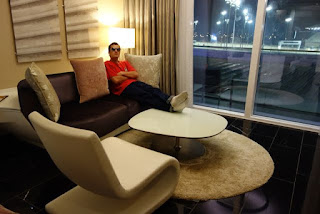 |
| Our sitting room at the Yas Viceroy, overlooking the racetrack |
 |
| The illuminated roof above our room |
Our spacious, ultra modern room has a large seating area with a kidney shaped purple couch, a curvaceous white resin chair and coffee table and an extremely large, flat screen T.V. Our hospital Romanian demonstrates the remote control options for the lighting and the sound system in the room and with a push of a button he opens the automated sliding shades that cover the floor to ceiling sliding glass door. Our door opens onto a narrow balcony overlooking a slanted corrugated metal roof and a brilliantly lighted race track just below. Initially, the three partitioned bathroom with frosted sliding glass doors between the shower, bidet and toilet and wash stand and bathtub seems luxurious, but the frosted glass lacks privacy and the arrangement is confusing.
 |
| Room door opening over the roof and racetrack below |
 |
| Abstract transparencies, Yas Viceroy Hotel, Abu Dhabi |
As soon as our luggage is delivered, John slips into swim trunks and we head to the roof top swimming pool. The rod and pod roof has a circular opening in the center and a full moon is framed and suspended above. We are in a flight path and every few minutes the silhouette of a plane passes by the moon. The alternating colored lights illuminate the pool in an ever changing pallet of purples, greens and blues. I feel as if I have stepped into a Star Trek episode.
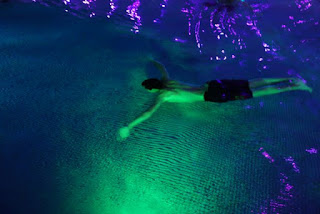 |
| John swimming in the Yas Viceroy roof top pool |
 |
| John, Yas Viceroy roof top pool |
There are 5 restaurants in the Yas Viceroy hotel and all are expensive. We peruse the various restaurant and menu options and choose the Arabic restaurant after we spot a Mezze selection for two that includes a choice of four hot mezzes for 100 dirham. ($35) The sign at the entrance to this elegant restaurant requires “upscale casual” dress and at best, John and I are wearing “frumpy traveler.” We straighten our shoulders and step inside. The interior décor is minimalistic Arabic style with soft golden lighting and a curved bar with glimmering bottles of liquor reflected in the gilded mirror behind. A dozen or more ornate shishas (waterpipes) are clustered at one side of the bar. A hostess glides towards us, welcoming us and asking if we wish to sit inside or if we might prefer to sit outside? We were unaware of the outside option but obediently follow her to an expansive patio overlooking the race track. There are tall obelisk shaped heaters to warm the night, flames rising high, and a half dozen other diners sit at tables at the edge of the patio watching the cars race around the track. We do not have reservations and are seated at a table off from the railing but this allows us watch the other diners and we still have a good view of the race track. We splurge and order two Arabic beers, ($6 each) the mezze platter and sit back and watch the show. In the corner against the railing is a canopied table with about 8 Arabic women, the adult women all wearing black abays; a pre-teen girl, an infant and a nanny are part of the entourage. The women are between 18-24 years old and one of them is smoking a shisha, blowing white clouds of smoke into the faces of her friends with no mind for the baby.
 |
| Yas Viceroy Rooftop Arabian Restaurant |
John is fascinated by the racing cars. The track is a professional one but John tells me that he thinks the drivers are just wealthy Arab men who just want a place to race their “toys.” John has watched videos about this on U-tube; that racing on the streets in the UAE became a problem and now the men with their Porches and Ferraris can reserve the track for an evening and burn rubber and testosterone without endangering others. John critics the drivers; most of who are cautious when coming to the curves but he applauds one driver in a red Porches who seems to have little fear and tears around the track much faster than the others. We soon surmise that the women, seated at the corner table, are somehow related to one or several of the drivers. Our four mezze plates arrive along with a basket of varied Arabian breads and a dish of pickles and olives. The spread is ample and we dip pieces of bread in hummus and share tiny lamb shanks, sausages and calamari as we listen to the revving and downshifting of the cars. This is the final night of our trip and John asks to smoke a shisha. A shisha, with two flavors of tobacco, costs 60 dirham ($16) John asks flavor advice from the shisha attendant and subsequently orders mint and grape tobacco. A few minutes later an ornate silver shisha is set on the floor beside John’s chair. It is 2 ½ feet tall and with tongs the attendant places hot coals in the dish above the prepared tobacco, puffs on the hose several times to get it started, and then inserts a fresh mouthpiece and hands it to John. John leans back, inhales and blows white clouds of mint scented smoke in my direction. I too take several puffs but inhaling smoke is foreign to me and my head spins on the second inhalation. We laugh, take photos of each other and when the coals burn low, head up to our luxurious room for 6 hours of sleep.
 |
| Inhaling mint and Grape shisha |
 |
| Exhaling mint and grape shisha |
Our trip is over and it has been amazing throughout. John and I are well matched as traveling companions and ending it with two days in futuristic Dubai has been perfect contrast to the chaos, colors and culture of incredible India.














